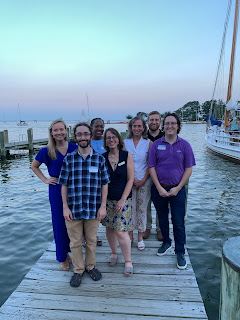The Sacredness of the Sea
by
Vickie Machado
The
sea is a sacred mystery. Covering over two-thirds of the Earth’s surface and holding over 1.3
billion cubic km of water, the ocean is the wildest, most expansive place on
earth. As of December 2021, the most accurate and precise estimate of the
deepest part of the ocean was 10,935 meters, roughly 6.79 miles down. To put
this in context, Mt. Everest, one of the tallest mountains on earth, is 8,848
meters high. On average, the ocean is 2.3 miles deep— another alarming depth
for many of us who have only waded out chest deep. Venture offshore by boat or
plane, far from land, and you will get a sense of just how massive the ocean
is, as every direction reveals a continuous horizon for miles to come. Whether
you’re
deep below its surface, in the middle of it, or simply on the shore looking
out, within this space rests the mysteries of life yet to be explored and
uncovered. There is a power that the sea evokes—a sacredness that asks us to
stop and listen.
The
expansiveness of the ocean often puts life in perspective bringing with it an
awe, fear, and humility when you realize just how big the world is. In some
cases, it’s
the same astonishment that met Moses at the burning bush or on Mt. Sinai
(Exodus 3)—the amazement of being in the presence of God. In other instances,
it’s
the gentle whisper Elijah heard in the midst of stillness after disaster—a
reminder to listen and pay attention in the midst of despair (1 Kings 19).
Still, feelings that arise with the sea may be comparable to the frustrations
that accompanied the Israelites (Exodus 15) or the tribulations that met Jesus
as each respectively wandered in their own wildernesses (Matthew 4). However
God decides manifest, the experience is somehow magnified by such vast and
powerful natural spaces.
It’s not just
the setting that invokes God’s presence but the ocean itself has a message that
highlights the intersectionality of our world and the justice we are called to
pursue. With increased research, the sea is shouting to be heard—plastics
polluting our water, fisheries being depleted, corals crying out like John in
the wilderness about what is to come. The rapid warming of our oceans is a
warning sign. According to NASA, 90% of global warming is occurring in these
very waters. With warmer oceans, comes the thinning of ice shelves; sea level
rise; coral bleaching; the loss of coastal protection, marine species, and
ecosystems; threats to food security; increasing diseases; extreme weather
events; and further pressure on coastal populations—nearly 40% of the world’s population.
Fifty
years ago, in October 1972, Congress enacted the Marine Protection, Research
and Sanctuaries Act (MPRSA), which prohibits unregulated dumping that would
harm human and marine health. As people of faith, we know the term sanctuary—it’s a place
of refuge, a safe haven, a shelter from the storm. Some of our churches may
even be sanctuaries for those seeking asylum. Sanctuary can provide a glimmer
of hope. The important recognition is that the same forces of climate change
that are causing warming seas, sea level rise, coastal flooding, ocean acidity,
and an overall strain on local resources are creating environmental refugees
and pushing people toward seeking refuge. Such connections show that we do not
exist in a bubble. Most of all there is a sense of wonder and reverence as the
creation teaches us about our Creator and our call to love our neighbors—fellow
humans as well as sea life and water. By caring for the ocean—as vast and unknown
as it may be—we are caring for each other.
Dr. Vickie Machado is a
third generation South Floridian and holds a PhD from the University of
Florida, where she focused her studies on Religion & Nature and Religion in
the Americas. She also serves as a leader for the Eco-Stewards Program, a
creative community that shapes, inspires and connects young adult leaders (ages
20-30) through storytelling and place-based pilgrimages focused on faith and
the environment.





